
Exploring the Impact of the Technology Acceptance Model on Modern Workplace Technologies-As we dive deeper into the digital age, the way we work continues to transform at a rapid pace. Modern workplace technologies—ranging from collaborative software to artificial intelligence tools—are reshaping how teams operate. At the heart of this transformation lies the Technology Acceptance Model (TAM), a framework that helps us understand why some technologies succeed while others falter. In this article, we’ll explore how the Technology Acceptance Model impacts the adoption of modern workplace technologies and what that means for organizations and employees alike.
Understanding the Technology Acceptance Model

The Technology Acceptance Model was developed in the late 1980s by Fred Davis to predict user acceptance of technology. It focuses on two primary factors:
- Perceived Usefulness: This refers to the degree to which a person believes that using a particular technology will enhance their job performance.
- Perceived Ease of Use: This indicates how easy and user-friendly the technology is perceived to be.
In essence, if employees believe that a new technology will make their work more efficient and that it’s simple to use, they are more likely to adopt it. This model provides a solid foundation for understanding how organizations can successfully implement new tools in the workplace.
Enhancing Employee Productivity
In today’s fast-paced work environment, productivity is paramount. The Technology Acceptance Model plays a crucial role in ensuring that employees embrace tools designed to enhance productivity. For instance, collaborative platforms like Microsoft Teams and Slack have become essential in many organizations.
When these tools are introduced, their perceived usefulness is often evaluated based on how effectively they can streamline communication and collaboration. If employees see that these tools can help them work more efficiently, they are likely to embrace them. On the flip side, if users find the tools cumbersome or difficult to navigate, the likelihood of adoption diminishes. (Read More: AI Technology: Development of Autonomous Vehicles and Smart Transportation Systems)
Case Study: Remote Work Tools
During the pandemic, companies adopted various remote work tools. Research showed that employees who perceived these tools as useful—facilitating better communication and task management—were more likely to integrate them into their daily routines. By focusing on the principles of the Technology Acceptance Model, organizations could tailor their training and support to enhance the perceived usefulness and ease of use of these platforms.
Influencing Change Management

Implementing new technologies in the workplace often requires change management strategies. The Technology Acceptance Model provides valuable insights into how organizations can facilitate smoother transitions.
When introducing new technologies, organizations should prioritize educating employees about the benefits and functionalities of these tools. This education helps to enhance perceived usefulness. Additionally, providing comprehensive training can improve perceived ease of use, empowering employees to feel more comfortable with the new technology.
Creating a Supportive Environment
Organizations that foster a culture of support and open communication tend to see higher adoption rates. When employees feel encouraged to ask questions and seek help, they are more likely to embrace new tools. In 2024, companies are increasingly recognizing the importance of creating a supportive environment that aligns with the principles of the Technology Acceptance Model.
Addressing User Concerns
Understanding the concerns and feedback of employees is essential in the technology adoption process. The Technology Acceptance Model highlights that perceived ease of use significantly influences acceptance. If users encounter challenges, their perception of the technology’s usefulness can diminish.
For example, if a new project management tool is introduced but employees find the interface confusing, they may struggle to see its benefits. To address this, organizations should actively seek feedback during and after the implementation phase. Regular check-ins and surveys can help identify pain points and areas for improvement, ensuring that the technology evolves to meet user needs. (Read More: The Use of AI Technology: Utilizing AI in Financial Data Analysis, Fraud Detection, and Investment Management)
The Role of Leadership

Leadership plays a pivotal role in technology acceptance. When leaders demonstrate a commitment to using new technologies, it sets a positive example for employees. This is particularly relevant in the context of the Technology Acceptance Model, as leaders can help enhance the perceived usefulness and ease of use through their endorsement.
In 2024, organizations are increasingly prioritizing digital literacy among their leaders. By equipping them with the skills to navigate new technologies, leaders can inspire confidence in their teams, making the adoption process smoother and more effective.
Measuring Success
Once new workplace technologies are implemented, measuring success becomes essential. Organizations should track metrics related to usage, productivity, and employee satisfaction. This data can provide insights into how well the technology aligns with the principles of the Technology Acceptance Model.
By analyzing these metrics, organizations can identify trends and make data-driven decisions about future technology investments. If a particular tool is underused, understanding why can help organizations address barriers and enhance employee engagement. (Read More: GOC Technology Transforms the FinTech Sector in Europe by Introducing Global Open Collaboration Solutions Based on Blockchain 2024)
Conclusion article Exploring the Impact of the Technology Acceptance Model on Modern Workplace Technologies
The Technology Acceptance Model remains a powerful framework for understanding user adoption in the modern workplace. By focusing on perceived usefulness and ease of use, organizations can better navigate the complexities of technology implementation.
In 2024, as workplace technologies continue to evolve, aligning strategies with the principles of the Technology Acceptance Model will be essential for success. By prioritizing employee education, creating supportive environments, addressing user concerns, and fostering strong leadership, organizations can facilitate smoother technology adoption and ultimately enhance productivity and job satisfaction.
As we move forward, embracing the insights provided by the Technology Acceptance Model will help organizations leverage modern tools to create more efficient, engaging, and effective workplaces.





